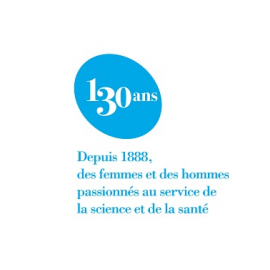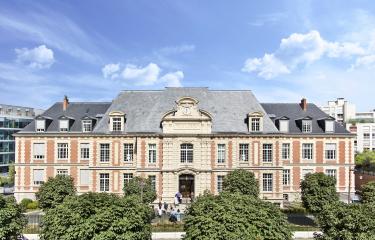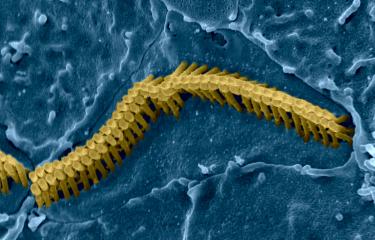As the Institut Pasteur prepares to celebrate its 130th anniversary on November 14, 2018, we talk to Jean-Pierre Changeux about the discovery of this ion channel-linked neuroreceptor that revolutionized neuroscience. On February, the researcher publishes a paper in Trends in Neuroscience providing an account of how this receptor's ion channel was structurally identified.
The nicotinic acetylcholine receptor was isolated in the 1970s by Institut Pasteur researcher Jean-Pierre Changeux and his team. It subsequently underwent several stages of identification before finally being described at atomic level, notably using molecular and structural biology methods.

In the 1970s you isolated the nicotinic acetylcholine receptor in the lab and have since contributed to numerous publications on this receptor. Why are you publishing a new article on the subject this month, this time from a historical perspective?
Forty years ago, we isolated the nicotinic acetylcholine receptor in collaboration with a Taiwanese colleague using an unusual marker – a snake venom toxin. This was the beginning of an extraordinary scientific journey. And 2018 is rather a special year for me as it is the twentieth anniversary of an important article describing how the brain nicotinic receptor is involved in nicotine dependence (see inset below). Against this backdrop, I accepted an offer from the scientific journal Trends in Neuroscience to publish an article addressing a specific chapter in the nicotinic acetylcholine receptor story, namely how the structure of the ion channel linked to the receptor was identified. This was an important step in research on the receptor.
So how was the acetylcholine receptor discovered?
It all started with the very notion of receptors. This notion is the legacy of Claude Bernard's work, which was continued by scientists in England. In the nineteenth century, Claude Bernard demonstrated that curare (used in general anesthesia) worked at the junction between nerve and muscle cells causing paralysis and loss of muscle tone. In 1905, the British physiologist John Newport Langley demonstrated that curare acts on the muscle side of the neuromuscular junction in a structure that he described as a 'receptive substance' or receptor. Langley pioneered research on the effects of curare, demonstrating that it inhibited the effects of nicotine since nicotine triggers muscle contraction and curare inhibits this effect on muscle.
Later, in the 1930s, Otto Loewi and Sir Henry Dale demonstrated acetylcholine's action as a neurotransmitter. Extensive electrophysiological and pharmacological research was subsequently carried out with a view to understanding what happens in nerves and the contacts (or synapses) between nerve endings and their targets when neural signals are transmitted, a process known as chemical synaptic transmission. However, this all took place after the Second World War.
How was the acetylcholine receptor isolated?
Previous biochemical studies had failed because insufficiently specific molecules had been used for tagging. By introducing a specific marker and using fish electric organ, a type of tissue that is abundant in cholinergic synapses [as demonstrated by David Nachmansohn in 1936 while working in Paris] it was possible to isolate the nicotine receptor studied by Langley. In the 1970s, I met a Taiwanese pharmacologist named Chen-Yuan Lee who was introduced to me by France Depierre, a talented researcher at the Institut Pasteur. This was to prove crucial. France was a student of Daniel Bovet in the great Pasteur tradition of medicinal chemistry [editor's note: she was also married to the vulcanologist Haroun Tazieff]. Although numerous teams were competing against each other at the time, we were the first to isolate the acetylcholine receptor thanks to the exceptional specificity of the toxin produced by the many-banded krait. The receptor was subsequently purified and the first components of its amino acid sequence were established by the Institut Pasteur. These were then confirmed by a host of researchers from around the world, in particular my eminent Japanese colleague, Shosaku Numa, who was the first to publish the entire Torpedo acetylcholine receptor sequence.
Was the next step to locate the ion channel in the acetylcholine receptor?
That’s right. Physiologists throughout the world were keen to identify this ion channel whose opening was observed when acetylcholine was applied. The assumption was that this channel was located in the part of the receptor that crosses the synaptic membrane, i.e. the transmembrane segments. In the 1980s, Jérôme Giraudat from my lab located the channel in segment MII by identifying one of the components of this channel, serine 262 [editor's note: by photochemical labeling using a channel blocker]. The researchers Shosaku Numa and Henry A. Lester [editor's note: a former post-doctoral fellow with Jean-Pierre Changeux] confirmed and documented this site based on directed mutagenesis analyses while also providing details of new structural elements of the channel.
Was this the first ion channel to be identified in this way?
Yes it was. This was the first time an ion channel's structure had been identified. The nicotinic receptor was also the first neurotransmitter membrane receptor to be discovered in the nervous system. This marks an important step in the history of neuroscience. We also demonstrated that although the ion channel is structurally separate from the site to which acetylcholine binds, this site remotely controls the opening of the channel. This is therefore an example of an allosteric interaction*.
* Allostery is a concept developed by Jacques Monod, Jean-Pierre Changeux and Jeffries Wyman in a series of articles; the main article in this series was published in the Journal of Molecular Biology in 1965: On the nature of allosteric transitions: a plausible model. Monod J, Wyman J, Changeux JP. J Mol Biol. 1965 May;12:88-118.
So numerous scientific contributions have been made in relation to the nicotinic acetylcholine receptor.
As is often the case in science, it is definitely true that this work was carried out by teams of researchers from around the world. And I should add that the story of this discovery shows that brain biology, which was for decades the domain of anatomists and physiologists, underwent a sort of revolution with the advent of molecular biology, a discipline in which the Institut Pasteur plays a leading role.
Source
Structural Identification of the Nicotinic Receptor Ion Channel, Trends in Neurosciences, February, 2018.
Jean-Pierre Changeux1, 2
1. CNRS UMR 3571, Institut Pasteur, Paris F-75724 Cedex 15, France.
2. Chaire de Communications Cellulaires, Collège de France, Paris F-75005, France.

Demonstrating the role of the nicotinic receptor in nicotine dependence
In 1998, a historic step was taken at a time of controversy over whether or not nicotine was an addictive substance. Jean-Pierre Changeux and his team, foremost among whom was an American post-doctoral fellow named Marina Picciotto, provided the first conclusive evidence of the role of the nicotinic receptor in nicotine dependence. 'Our work with others helped demonstrate that the nicotinic receptor is indeed involved in nicotine dependence and that neurobiological dependence mechanisms exist.' This marks the start of genetic analysis of nicotine dependence mechanisms.
Source
Acetylcholine receptors containing the β2 subunit are involved in the reinforcing properties of nicotine, Nature, 08 January 1998.
Marina R. Picciotto, Michele Zoli, Roberto Rimondini, Clément Léna, Lisa M. Marubio, Emilio Merlo Pich, Kjell Fuxe & Jean-Pierre Changeux.






